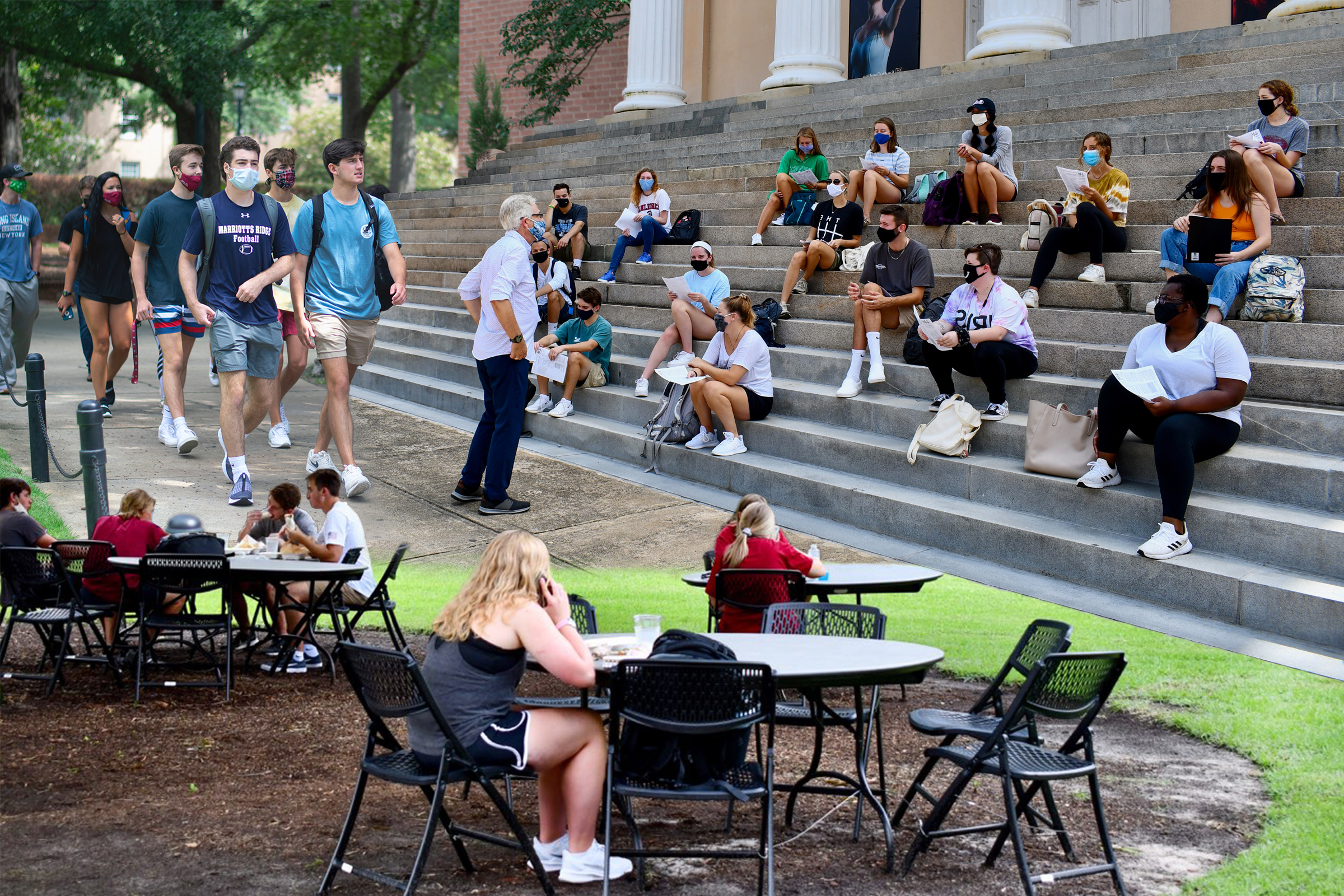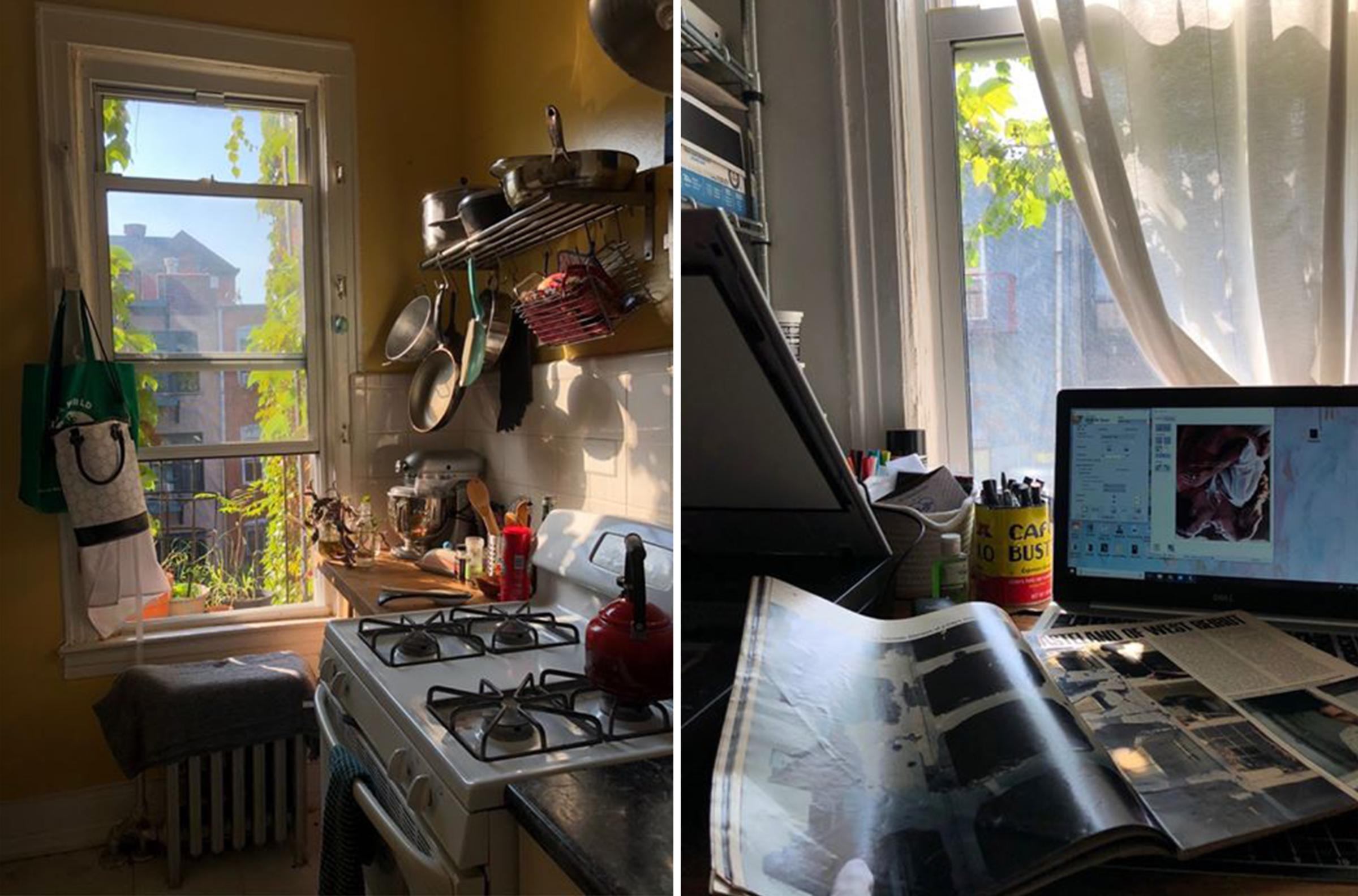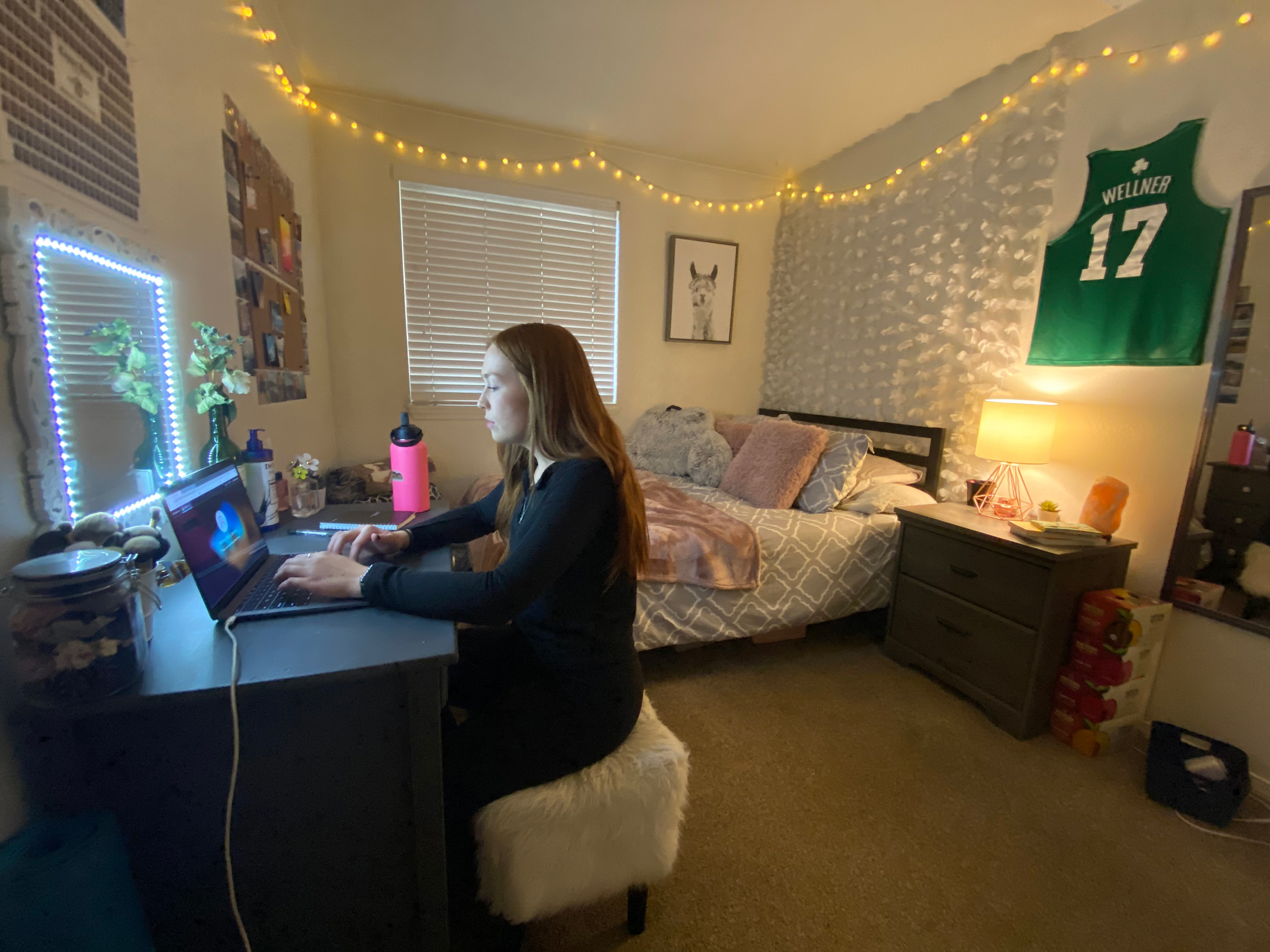
Grace Mungle is glad she and her roommates at Ball State University in Indiana spent some time this summer redecorating their dining room before moving in. They’ve logged many hours at the sleek black table this fall: within days of returning to campus in mid-August, Mungle, 20, and all four of her roommates tested positive for the coronavirus. She’d only attended an in-person class once, her speech and audiology lecture. Then she and her roommates started their quarantine for the duration of their collective illnesses, and the table is where they’ve eaten all their meals and spent hours taking virtual classes and doing homework together, a five-person quarantine pod. At night, they’re running through old TV shows: Hannah Montana, Lizzie McGuire. It’s not quite the junior year they had in mind.
“I had not been to a party, and I still got it,” Mungle said over the phone, over a week into her quarantine. Her symptoms—mostly bad headaches and congestion—were abating. But her frustration with her college, and the situation that thousands of students across the country are dealing with, was not fading quite so quickly. “I’m really just frustrated with how Ball State handled the whole situation with COVID. They didn’t do anything to help us, to help prevent this,” she said. (Ball State did not respond to request for comment.)
Since colleges and universities restarted classes for the fall semester in August and September, thousands of new COVID-19 cases have been reported, with outbreaks spreading from many campus activities. The University of Alabama reported well over 2,000. The University of South Carolina reported over 2,000 as well. The small town of Pullman, Wash., home to Washington State University, briefly claimed one of the country’s highest positive rates as it edged towards 1,000 cases. (By the second week of September, it was down to number two.) This is a shift from last spring, when young people were considered a demographic at low risk for contracting COVID-19. Now, 23% of all positive COVID-19 tests in the U.S. are young people. In the last three weeks alone, the cases for the group aged 18 to 29 increased 10%—nearly 100,00 new cases, more than any other group.
Part of this increase is due to expanded testing: as students returned to campuses, their schools made it easier—sometimes mandatory—to check their COVID status. But the rising numbers are also due in part to the unchanged conditions of college life: indoor classrooms, basement parties, shared housing—in short, everything that makes social distancing difficult.
Over a dozen students contacted by TIME shared varying levels of concern about their campus experiences, but nearly all seemed resigned to a year of limited education, wasted finances and ongoing health risks. And as the long-term effects of the coronavirus—both on the health of our population and the economy—remain unknown, they also represent a generation with a future filled with uncertainty.

Kyle Caruthers, 20, transferred to Temple University halfway through college: he’s studying photography, and joined their specialized studio art program. He moved into an off-campus apartment with two fellow art students in mid-August, and attended his first drawing class in person—with masks on, of course. “When we started our courses, it wasn’t as bad as we thought,” he said. But that was week one. By week two, the campus shut down following a case spike, and Caruthers’s art classes were relegated to online learning. “It’s kind of doomed,” he says of the rest of his semester.
He and his roommates created a studio space in their living room, making the best of their situation. But he is disappointed in the college. “They should have not opened up campus to begin with,” he said. “We’re just not getting a thorough and honest explanation.” An anonymous Instagram account popped up accusing the school of misreporting COVID cases and underplaying the severity of their situation; it’s since disappeared, but other accounts are making similar points. Meanwhile, Caruthers and his nearly 40,000 classmates are paying full tuition—which can come to nearly $20,000 annually for out-of-state students—for an education that isn’t meeting their expectations. (Temple is now offering housing refunds to students moving out due to the remote class shift. The university did not respond to request for comment.)
“Now more than ever we’re really questioning where our money is going,” Caruthers said. During his virtual Gender in America class, a breakout Zoom session with his peers quickly devolved into candid conversation about their real-life concerns, not the class reading. “People are really not happy about things right now,” he said. “I know a lot of people who want to drop [out]. It’s infuriating that we’re in this situation.”
Colleges are in a difficult situation too: to be financially solvent, they need students to pay up. But to keep students on campus at full tuition, they need to accept significant risks. At University of Alabama, which has seen over 2,000 reported COVID cases so far since reopening on Aug. 19, concerns about those risks—and who would be responsible—surfaced early. In July, law student Haley Czarnek raised the alarm when the university sent out a “pledge,” with students required to sign a contract including language that they would “voluntarily assume” risks that included “severe illness or death.”
“It jumped out at me,” Czarnek said. She published an op-ed in the student paper, and the university quickly issued a revised version of the pledge, walking it back. Students on other campuses have made parallel efforts to counteract similar administrative language. But the schools’ insistence on placing responsibility in the hands of students—and operating from the expectation of business as usual—is upsetting to many. “It encourages an attitude that there is normalcy that doesn’t exist,” Czarnek said, noting that college students in particular are young and, frankly, not always great at making responsible decisions. By the second week of September, the U of Alabama president was sharing information about amped-up testing programs, with a moratorium on official events. By the third week, the rate of new cases dropped.
Czarnek’s concerns, however, have been borne out across the country: for many college students, back to school season means parties and tailgates, raucous Greek life events and general debauchery. Social media is rife with documentation of maskless parties and accounts of whole houses and dorms beset with infections. Schools, for their part, have varied in their willingness to crack down—or even to limit in-person attendance. While some preemptively went fully virtual, others have made more tepid efforts, like limiting on-campus housing to minimize the student population in their care, or shutting down indoor community spaces like gyms and libraries. Others left instruction up to professors, who have had to make the call on whether their classes would be in-person or remote. The result has been a patchwork of mandates and guidelines, often shifting week to week.
Lacking guidance, many young people returned to campuses this fall no matter the classroom situations, with apartment leases already signed and life amongst friends a tantalizing prospect. After six months of living at home with limited social opportunities, it should come as no surprise that thousands of reunited young people have broken social-distancing rules. The universities are not shocked. “Despite our best efforts to strongly encourage social distancing and mask wearing among our student population we knew we would experience positive student cases,” a spokesman for the University of South Carolina, which clocked over 2,000 cases since reopening but considers their “alert level” to be “low,” told TIME. “While students have been very compliant on campus, it’s proven difficult to influence off-campus behavior and we have had to issue sanctions to students for hosting or organizing large off-campus parties.” They’ve administered more than 17,000 tests since the beginning of August in an attempt to get a grip on the situation.
Rita Naidu, 22, is a senior studying public health and a managing editor of the student paper The Daily Gamecock at University of South Carolina. She watched as the numbers ticked up—even while the university left class decision-making in the hands of individual professors and postponed athletic events. (Their first football game is still scheduled for Sept. 26, with tailgating discouraged.) “There’s a huge dichotomy” between students taking COVID seriously and those who are acting like life is normal, she said, sounding tired; as part of the breaking news team, it’s been a tough fall trying to keep up with announcements and classes. Over half of students, in her estimate, are brushing off COVID concerns. The mayor and university administrators may have cracked down on official student gatherings, but the previous night she’d watched as over 100 of her peers gathered at a bar just outside city limits—maskless. “There’s a growing sense of fear, for sure. Even for me,” she said. “The parties aren’t going to stop.”

For some students, a completely virtual college experience is at least partially a relief. In New York City, a former epicenter of COVID-19, new cases have dropped down to about 200 per day. But at Pratt Institute, where Sydney Ellison, 20, is a student, about two-thirds of classes are online, on-campus housing is closed and there is strict security for anyone entering campus spaces, including temperature checks. Ellison, who has an autoimmune disorder and asthma, is living at an apartment in Brooklyn—glad she doesn’t have to risk her health to go to school. “It screwed over a lot of my friends,” she said of Pratt’s closures, “but they were very smart.” An arts school, Pratt is known for plugging students directly into the city’s arts scene. That side of the education is at a standstill now. Ellison thought about deferring or withdrawing, but the finances were complicated. And ultimately, remote learning hasn’t been so bad; in fact, virtual connectivity has ironically made some networking even easier than before. The school’s strict policies have given her—and some of the faculty members she’s spoken to, who are in a more at-risk age group—peace of mind.
Still nervous about a fall spike in cases in the city, Ellison has watched with concern as her peers at other campuses around the country have been going to class, congregating and becoming sick. “I am really grateful about how my campus is handling it in comparison,” she said.
Naidu, recapping the scenes of partying at USC, sounds jaded by her own peers’ blasé attitudes toward illness. “You’ll hear people groan,” she said, if you’re that person who requires everyone to mask up. At Clemson, also in South Carolina, sophomore Elizabeth Rew has also been disenchanted. Rew’s mom has cancer and is immunocompromised; at home over the summer, Rew carefully maintained strict health protocols for her family’s sake. Now, she’s living in a house at school and discovering that her peers are not always taking things like social distancing quite as seriously. “It’s exposed people’s true character,” she said. The social pressures are difficult to manage. “You don’t want to come across as weird,” she said, by keeping extra distance. In the meantime, she’s doing a lot of at-home YouTube workouts, taking digital classes and being as conscientious as she can be. Clemson counted nearly 1,000 new cases by mid-September, according to their tracking dashboard. “I hope that even if I wasn’t sick I would think about people like my mom. I think it would be selfish just to have the college experience—it’s just four years of my life,” she said, reconciled to this new reality. Above her desk, Rew keeps framed photos of friends and family, a cross, and inspirational quotes from Winnie the Pooh, as well as one final poster: “Seek beauty in all things.” It’s a helpful mantra right now. And it’s the little things that offer respite: the charcuterie board she made with her roommates at home last week, a drive-in event—with cars in distanced pods—to look forward to.
Some campuses are making headway in keeping case numbers low, especially those with the financial means to do so. At Yale University in New Haven, Conn., the Dean announced the very first known case since classes resumed in a school-wide email in week one of class; by Sept. 17, their online dashboard showed three cases. Students have designated twice-weekly testing. Meals for on-campus residents are handed out in plastic bags, and dining hall tables are partitioned into two-tops with plexi glass. Markers on the quads note appropriate spots for students to sprawl, distantly, on the grass. Over the summer, a professor’s dire email warning to students went viral; she suggested students prepare themselves to witness deaths. But Ahmad Zaidi, 21, a senior studying applied math and history, is nonplussed by the hype, even as the debate about sufficient safety measures rages on. “Everyone’s kind of adjusted,” Zaidi said. “I’m pleasantly surprised that things are kind of fine.” Students were tested upon arrival and quarantined in single rooms until they received negative results. Now the residential hall he’s living in exists in a mostly self-enforced bubble. He’s been bingeing the second season of Succession and eating outside. Classes are held virtually. Life goes on. “Historically speaking,” he said, a shrug in his voice, “people don’t talk about the Spanish flu that much.”

But not all universities have the capacity to test twice weekly, or to offer up campus housing with adequate space for each student to live alone, or to provide meals safely. Even those that cancel class have had their challenges. Molly Wellner, 21, moved back into her apartment in Pullman, Wash. on Aug. 17. “Having a senior year—I was looking forward to that,” she said. A computer science major at Washington State University, she’d spent the summer at home in Tacoma working 60-hour weeks doing accounting for a fruit company. WSU had announced early on that classes would be fully virtual—but Wellner and her three roommates had already signed their lease. On Aug. 27, the first roommate woke up with symptoms. On the 28th, Wellner felt sick, too. By the 29th, all four had COVID. Soon, it wasn’t senior year they were looking forward to, but just being able to leave their apartment at all. “At this point, I’m kind of expecting incoming spring to be the same,” she added, resigned.
With over 800 confirmed cases and counting in a town of 15,000 full-time residents and about 20,000 students, WSU claimed the dubious title of being one of the country’s current COVID hotspots. But Phil Weiler, WSU’s Vice President for Marketing and Communications, notes that the positivity rate for COVID infections is going down. Conscious of pressures on the local health system, WSU is now providing free testing for the off-campus students who returned. Enforcement of social gathering restrictions has increased, too; now, party attendees are getting citations, not just hosts. Student leadership has come up with pithy slogans: “Practice safe six,” for distancing, is memorable.
For her part, Wellner is conflicted about her return to Pullman: “The local economy needs students here to keep businesses up and running,” she said, but at the same time, “I do feel a little guilty that we are putting Pullman’s permanent community at risk.” But for Wellner and her roommates, taking time off or going home also don’t feel like options. Graduation looms, and they have jobs and internships lined up. College will end whether or not they are quarantined for the rest of it. “As frustrating as it is… I think it’s really comforting knowing how many people are going through the exact same issues,” she said. Weiler concurs: “Everybody’s reaction in this situation has been understandable,” he said. “There should be no fingers pointed at any particular group.”
Naidu’s USC graduation is still scheduled for December, but she knows there won’t be much of a celebration. Her dad wanted her to consider transferring to a school closer to home in North Carolina, where they wouldn’t be paying out-of-state tuition. Her mom, who never graduated college, may be sad not to watch her daughter walk. Naidu loves USC, but despite fears about an uncertain job market, she admits college’s charms have now waned. “I’m pretty ready to just get out,” she said.
More Must-Reads from TIME
- Donald Trump Is TIME's 2024 Person of the Year
- TIME’s Top 10 Photos of 2024
- Why Gen Z Is Drinking Less
- The Best Movies About Cooking
- Why Is Anxiety Worse at Night?
- A Head-to-Toe Guide to Treating Dry Skin
- Why Street Cats Are Taking Over Urban Neighborhoods
- Column: Jimmy Carter’s Global Legacy Was Moral Clarity
Write to Raisa Bruner at raisa.bruner@time.com